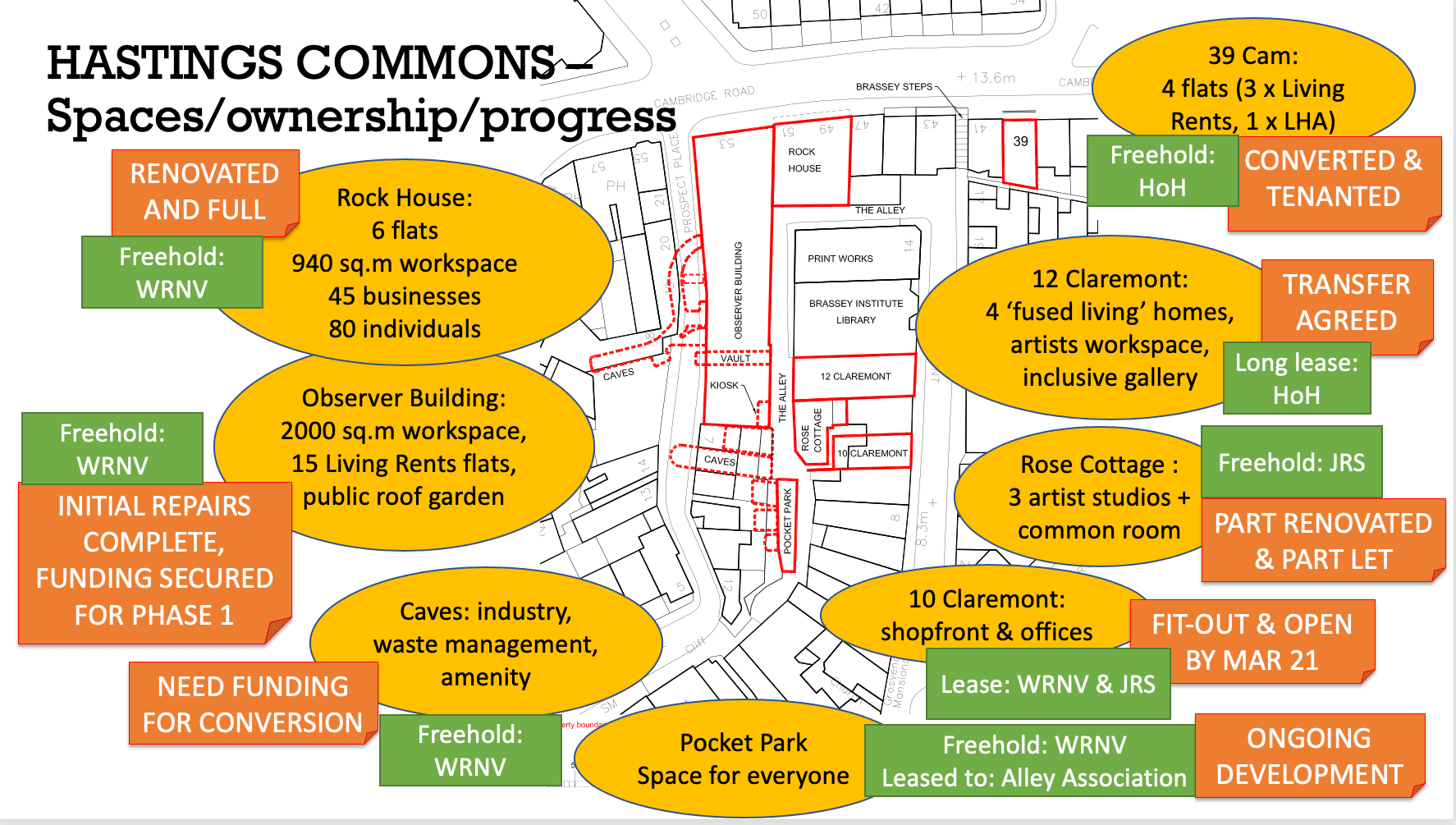Featured image: Hastings Commons CLT credit Johnny Thompson
The UK government has announced up to £5bn of investment for 339 “overlooked” communities across the UK to spend on boosting high streets, parks and public spaces. This is a rebadged and expanded ‘Plan for Neighbourhoods’, and before that ‘Plan for Towns’. With this announcement 169 more areas will receive £20m to spend over a decade, while a further 95 places will receive a one-off payment of £1.5m.
The money will be targeted at improvements backed by the local community – with the government saying spending would only be approved if community groups, local organisations and social clubs have been involved in deciding how the money will be spent. Neighbourhood Boards will need to be created, and agree on a plan to spend the money in their area.
Community Land Trusts are named as one of the ‘pre-approved’ ways to spend the money, thanks to our advocacy. So what role could CLTs play in creating safer, healthier neighbourhoods where communities can thrive?
The government’s guidance on pre-approved interventions mentions CLTs in connection with housing. Neighbourhood Boards could use some of the money to set up a CLT if one doesn’t already exist; to build up the membership and leadership of the CLT; to pay for a manager; and for project-specific costs like project management, consultations, fees for architects, and so on. We know these are barriers, and discussed these suggestions with officials when they were drawing up the guidance.
But the role of CLTs could go far beyond this. Looking at some CLTs in places where funding was already announced, we can see how community ownership could play a much bigger part in neighbourhood renewal. Take Hastings Commons, for example:

This longstanding CLT takes derelict and difficult buildings around the White Rock area of Hastings into community custody, transforming them into social spaces, homes and workspaces that will always be affordable and open to all.
Its activities and assets including housing, but also pre-approved interventions for Pride in Place under the headings of regeneration, the high street, heritage, community wealth, supporting local business, community cohesion, health and wellbeing and more.
This is because Community Land Trusts are all about locally-led neighbourhood transformation, buying and developing land and buildings to create a more socially, economically and environmentally sustainable community. The idea is to bring all these themes together into a single democratic, community-led organisation, which can then act as an asset-owning platform for buisnesses and community groups and residents.
The Community Land Trust can lease buildings to others, and partner with them — just look at the astonishing variety of neighbourhood development in other examples like Calder Valley CLT and St Ives CLT, for example.
This is also about ownership with a purpose. Regeneration can often displace communities – residents and businesses improve the area, then landlords hike up rents and they can’t afford to stay. A lot of community businesses already struggle to find spaces they can access and afford. Community Land Trusts are the community’s landlord, ensuring land and buildings remain affordable for the people, communities, businesses and charities that are regenerating their neighbourhood. This should be a key part of the economic strategy for all regeneration. It builds equity, agency, community wealth.
What’s more, investment through initiatives like Pride in Place can sit cheek-by-jowl with extractive development and ‘regeneration’. Is a neighbourhood helped by a bit of cash and ownership of one or two buildings, while a developer is demolishing social housing and building overpriced an cultural centre next door? A council could chose to take a holistic neighbourhood approach, recognising and empowering the Community Land Trust to be a partner in the regeneration of sites through the Local Plan. Communities are already organising around CLTs, up and down the country, campaigning for and sometimes winning this right.
Some neighbourhoods may choose to use their Pride in Place Funding for things that don’t require asset ownership, such as supporting local volunteering groups, or improving council streetlighting.
But if they want to protect, refurbish or develop homes, shops, workspace, social spaces, green spaces and anything else, the Community Land Trust is a great way to brings these things together. It is “pre-approved”, is defined in law, recognised in national planning policy, and enjoys various legal advantages to better protect assets in perpetuity. These features make the CLT model well placed to form part of a joined-up strategy, linking Pride in Place funding with the Local Plan, Assets of Community Value and wider neighbourhood governance arrangements.
And of course you can join a peer network of hundreds of communities doing the same thing, and working together to change the systems that hold communities back.
The Pride in Place money could not only deliver great results with the £20m. It could also be the catalyst for a CLT that goes on to do much more, as the examples above show. Creating a community-owned, community-led organisation within neighbourhoods to proactively develop and transform their neighbourhoods.
We’re very happy to support any Neighbourhood Boards and councils interesting in exploring this, and any CLTs in places with funding, so please get in touch!
